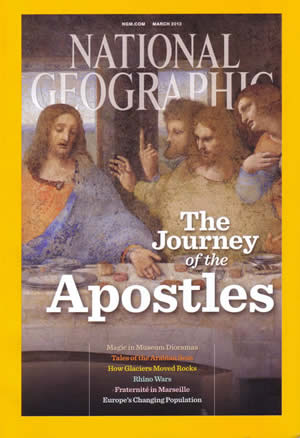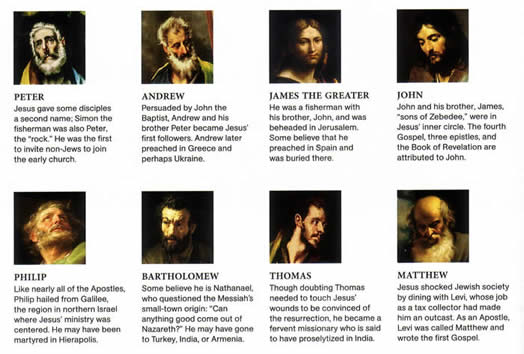Ilankai Tamil Sangam30th Year on the Web Association of Tamils of Sri Lanka in the USA |
|||
 Home Home Archives Archives |
Of Martyrdom and HopeLessons from Early Christian struggleby Sachi Sri Kantha, April 2, 2012
Front Note (written in April 2012) April 8th being the Easter Sunday for this year, I provide an earlier item of mine. I wrote the following essay 11 years ago to the now-defunct Tamil Nation website on April 18, 2001. This was before the Sept.11, 2001 tragedy when George W.Bush was the President and LTTE was making waves in the South Asian region. It was written to counter the anti-LTTE propaganda of the dubious University Teachers for Human Rights (Jaffna) organization, manned by Rajan Hoole, K.Sritharan and Daya Somasundaram. I wish to add here only one paragraph from Andrew Todhunter’s article, ‘In the footsteps of the Apostles’ [National Geographic, March 2012, p. 48].
Now that LTTE had lost its military base in Jaffna, I wonder where are these three saviors who promoted themselves and their career prospects with notices in the mass media that they were chased out of Jaffna due to LTTE’s aggression on their organization. Now is their opportunity to return to Jaffna and continue their human rights work for Tamils and Muslims against the aggression of Sri Lankan regime. If they don’t do this, they will be exposed as phonies and hypocrites. These guys did maintain a website [http://www.uthr.org/]. When I accessed it today (April 3, 2012), the last update of this website was on January 2, 2010; 27 months have passed since then. What happened to these three guys? Have they run out of steam after the elimination of LTTE’s military muscle? Or is it that their sponsors have deserted them lock, stock and barrel? Or, are they still in hiding? If it’s so, from whom? Answers to these five questions may offer some clues to their past posturing from 1989 to 2009. ****** My April 2001 Essay Last Sunday was the Easter Sunday. American President George W. Bush had noted in his Easter message: "In this season of renewal, we remember that failures in life are never final, that hope leads us closer to the truth, that in the end, even death itself will be defeated. And that is the shared belief of many faiths, and that is the promise of Easter morning." (New York Times, April 16, 2001). Simple thoughts, worth repeating umpteen times, whether they emanate from the lips of American President or from an Eelam Tamil refugee.
Nine years ago, I wrote a sympathetic review for The Broken Palmyra, in the Tamil Nation (April 15, 1992). In that review, quite a number of lapses evident in the book were not pointed out, since I felt that the rookie authors deserved some leniency. But the passage of a decade and continuing anti-LTTE campaign carried out by these scribes warrants me to critique their scholarship again. While their lack of knowledge in history is pardonable, their pretension to assess LTTE in harsh terms (without studying the early history of Christian Church) cannot pass unchallenged. Here is an excerpt from the Broken Palmyra, about the martyrdom practised by the LTTE. "The religion of the LTTE also provided for its devotees the emotional involvement of blood sacrifice. The sacrificial victims were those chosen by chance and sometimes by choice, to die in operations....The power of such a religion to captivate men's minds, make them forget all norms of civilization and morality and weld them together as a hysterical and destructive force, is enormous. But most Tamil civilians were looking for security. Little did they realize that what the LTTE was offering them was permanent conflict, destruction and suicide...." [page 100] The scribes of Broken Palmyra had written in their preface:"We felt strongly that the [Tamil] community must revive and to do so we must face the truth in all its nakedness, both about ourselves and about all those who purported to be our saviours". While pretending to be the seekers of truth, these scribes had valiantly tried to show that martyrdom and suicides of LTTE fighters are unacceptable to the civilized world. I wish to expose that, true to their acknowledgement, these moralists are ignorant about the history of Christian Church, among many other things. Historians have presented evidence that during the first three centuries of the first millennium, martyrdom was a weapon of choice for Christians in their fight against the Roman Empire. Even the death of Jesus Christ is attributed as a suicide (a voluntary act).
Death of Jesus Christ "Martyrdom was a fact of life for the early Christians, who felt a sort of apocalyptic intensity and excitement that has little role in the mainstream Western churches of the twentieth century....A number of Christian thinkers have seen the death of Jesus as voluntary....St.Augustine agreed on the voluntary aspects of the death of Jesus: 'His soul did not leave His body constrained, but because He would and where He would and how He would.' [Augustinus, The Trinity, 4] Centuries later, St.Thomas Aquinas argued very much the same thing in his discussion of whether Christ was slain by another or by Himself [Summa Theologica, 3.47.1]. Aquinas began by offering three 'objections' to the idea that Christ was slain by another. First, he offered the citation from John: 'No man takes my life from Me, but I lay it down of myself.' [John 10.18]. Second, he cited Augustine: 'Those who were crucified were tormented with a lingering death'; this did not happen in Christ's case since, 'Crying out, with a loud voice, He yielded up the spirit.' [Matt. 27.50]. Third, Aquinas again cited Augustine's view that Christ willed His soul to leave His body. At the same time, Aquinas pointed to a seemingly contradictory passage in Luke [18:33]: 'After they have scourged Him, they will put Him to death.' Aquinas attempted to resolve this seeming contradiction by distinguishing between direct and indirect causes. Christ's persecutors were a direct cause of His death. Christ was an indirect cause of His death, however, by not preventing this: 'Therefore, since Christ's soul did not repel the injury inflicted on His body but willed His corporeal nature to succumb to such injury, He is said to have laid down His life, or to have died voluntarily.' [Summa Theologica, 3.47.1]" (pp.44-45) Martyrdom of Early Christians "Martyrdom was a major issue in the early Church. In general the Romans were little interested in anyone's religious beliefs, but the Christians seemed to be political trouble makers, if not saboteurs or rebels...By the late first century, the Roman government had begun to feel that force should be used to make Christians behave like good Romans and particularly to show a patriotic respect for the government, including the offering of sacrifice to the emperor. A correspondence between the Emperor Trajan and Pliny, his governor in Bithynia, discussed the Christian problem [Pliny, Letters, Book 10] Many Christians responded by refusing to compromise their faith in any way, and gave up their lives as martyrs (the Greek term for witnesses) for their faith. Martyrdom was often the only choice for the Christian, but, there was not only the acceptance of martyrdom as unavoidable, but also a desire - and indeed an active pursuit - of death. One of the early martyrs was Ignatius of Antioch who was fed to the beasts in the arena in Rome around 107....To Ignatius, martyrdom seemed to offer the hope of meaning in a life that otherwise has no inherent worth. There was thus a pressure to offer up one's life both because of the Christians' uncomfortable political status in the Roman Empire and also because of the themes of death and martyrdom so central in the New Testament. Still, as much as Ignatius might long for martyrdom, he seemed more to wish not to avoid it rather than seek it as actively as many others did. Christians were still being persecuted in the middle of the 3rd century when Bishop Cyprian of Carthage was executed for his faith by the Roman officials. The church was now larger, however, and its adherents more militant. Martyrdom was no longer unusual, and many staunchly devout Christians went to their deaths before crowds in the arenas or, more privately, in prisons....Several themes appear repeatedly in Cyprian's writings. First, he discussed how much the world hated the Christians. There was of course much ill-feeling between Christians and pagans in the 3rd century. For Cyprian, however, the theme of hatred appeared to be a theological concept. He quoted Luke (6.22): 'Blessed are ye when men shall hate you.'....Clearly a passionate desire for martyrdom invigorated Christianity during these years of persecution." [pp. 47-49] This week's cover story of U.S.News and World Report [April 16, 2001] provide interesting snippets on the history of early Christian Church. What was interesting to me was the statistic, that at the end of the A.D. 1st century [around the time when Ignatius of Antioch became a martyr] the number of Christians amounted to only 10,000. This is the figure quoted by many sources now regarding the active members of LTTE as well. In sum, contrary to the condemnation by the scribes of the Broken Palmyra on the martyrdom and suicide of LTTE rebels, based on the descriptions of historical scholars, I see little difference between the actions of early Christians (who struggled for nearly 300 years) to establish Christianity faith and the members of Tamil Tigers. *****
|
||
|
|||

 What seems unappealing to me are the condescending tracts and analyses persistently presented by the critics of LTTE on the futility of martyrdom and suicide by the Tamil Tigers. One of the most touted anti-LTTE books, written in sloppy English, was The Broken Palmyra, which first appeared in 1988. In the Authors' Preface, dated April 1988, the scribes acknowledged their lack of expertise frankly as, "We are not professional writers or historians." However, since its authors were Jaffna Tamils, the book carried an authoritative stamp of one which had read the mind of Eelam youth. Two of its authors (Rajan Hoole and Rajani Thiranagama) were Christians by birth and they portrayed the LTTE movement as a sinistral force, equating it to the "official religion of the Third Reich".
What seems unappealing to me are the condescending tracts and analyses persistently presented by the critics of LTTE on the futility of martyrdom and suicide by the Tamil Tigers. One of the most touted anti-LTTE books, written in sloppy English, was The Broken Palmyra, which first appeared in 1988. In the Authors' Preface, dated April 1988, the scribes acknowledged their lack of expertise frankly as, "We are not professional writers or historians." However, since its authors were Jaffna Tamils, the book carried an authoritative stamp of one which had read the mind of Eelam youth. Two of its authors (Rajan Hoole and Rajani Thiranagama) were Christians by birth and they portrayed the LTTE movement as a sinistral force, equating it to the "official religion of the Third Reich". I provide excerpts from the book, A Psychology of Hope -An antidote to the suicidal pathology of Western Civilization by Kalman Kaplan and Mathew Schwartz (Praeger, Westport, CO, 1993) on two themes: the death of Jesus and martyrdom of early Christians.
I provide excerpts from the book, A Psychology of Hope -An antidote to the suicidal pathology of Western Civilization by Kalman Kaplan and Mathew Schwartz (Praeger, Westport, CO, 1993) on two themes: the death of Jesus and martyrdom of early Christians.